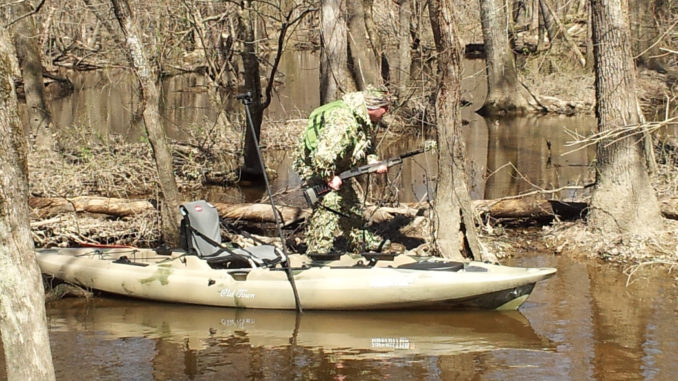
Kayaks, canoes can put you in prime tom turf
Late-season gobblers can drive a hunter insane. They become wary of the same old calls from the same old spots in the same old fields. Though they may still roost in the same areas, they may avoid feeding grounds that have had constant and consistent hunting pressure in prior weeks.
With this in mind, a little out-of-the-box thinking can prove beneficial in filling your tags during the waning weeks of the season.
Turkeys like hardwoods and water. North Carolina has numbers of creeks streams, and narrow rivers embedded in beautiful, thick hardwoods. Along these stretches, it is not uncommon to run upon a roosting area during the heat of the summer or the rut period of deer season. So if you can find turkeys then, you can find them now. Floating these slow- flowing waters can put you right in the middle of the action without spooking them.
Turkeys do not always answer a call. Your typical crow and owl locator calls do not always work. The same mouth calls or slates also become redundant when overused during a 3- or 4-week period. A longbeard has survived to trophy size because he has learned to be suspicious. He may investigate what is creating the sounds, but he is less likely to go marching into the field with his chest puffed out and his tail feathers fanned. Set-ups on or near the water deep in the hardwoods can fool a tom into coming out in the open quickly. If you know where the roost is, and you know the fields they feed, you can set an ambush point between.
When turkeys are close by, you must be ready. While floating a creek or river, bounce your calls between a hen and a short gobble. This can initiate a sequence where the tom believes a jake is trespassing on his area and get him to talk. Do not overdo it. You are looking for the tom to tell you where he is, not to bring him down on you. You still have to get out of the boat. Many of the waters have high banks during mid-May unless there have been recent rains. By pulling up to the bank, laying your firearm on the shore, and tying the kayak or canoe to a nearby tree, you can exit quietly and begin a search and stalk.
Many people use a stake-out pole or pointed push pole for anchoring. In a sit-on-top style kayak, you can actually use your pole through a scupper hole to keep the kayak in place rather than tying it down.
Once out of the water, be ready for anything. Turkeys are less pressured in these areas and do not hesitate to charge right in. Last year for instance, my daughter and I were set up on a well-used field turkeys were using regularly. I had a couple of toms talking back and forth early and worked them for more than two hours. We caught glimpses of them as they edged the field about 20 yards inside the hardwoods. We never got them to come out to the decoys in the field but watched them come in behind us and strut a mere 20 yards back.
What we noticed was though they never came out into the field, they moved quickly in the woods. In less than 30 minutes, they came from over 300 yards away from where we first glimpsed them through the binoculars. They were suspicious and weary of the open field, but they had no precautions investigating while still in the woods.
While it is legal to float streams, creeks and rivers, hunting on land requires proper permission. The float can gain you access to the game, but not access to hunt the land adjoining it. Game lands and large leases are ideal for using a kayak or canoe. Small hunting areas may not be.
Just because you are hunting turkey does not mean you throw all caution to the wind. When hunting without a blind, I prefer a leafy camouflage suit. However, I still use a personal floatation device when accessing an area by kayak. It can be worn under or over the camo, but with the warmer temperatures of early and mid-May, I usually wear it on the outside. This way I can remove it quickly, and I do not get as hot once on the shore.
After bagging a longbeard you now have unique setting for the hero shot. I keep my cell phone in a zipper-style sandwich bag with easy access. The bag protects it from the water and elements during the float in. You can prop the camera against a log, tree, limb or even a holder mounted on the kayak or canoe to get the angle of the shot you are looking for. Using the timer on the phone’s camera settings, you start the shutter count down and go back to your bird and pose. The background will help tell the story of how you found your trophy and offers an amazing shot of something different than a grassy field. Do not hesitate to use the flash setting; the canopy of the hardwoods makes lots of long shadows, and the flash will highlight you and your bird.



Be the first to comment